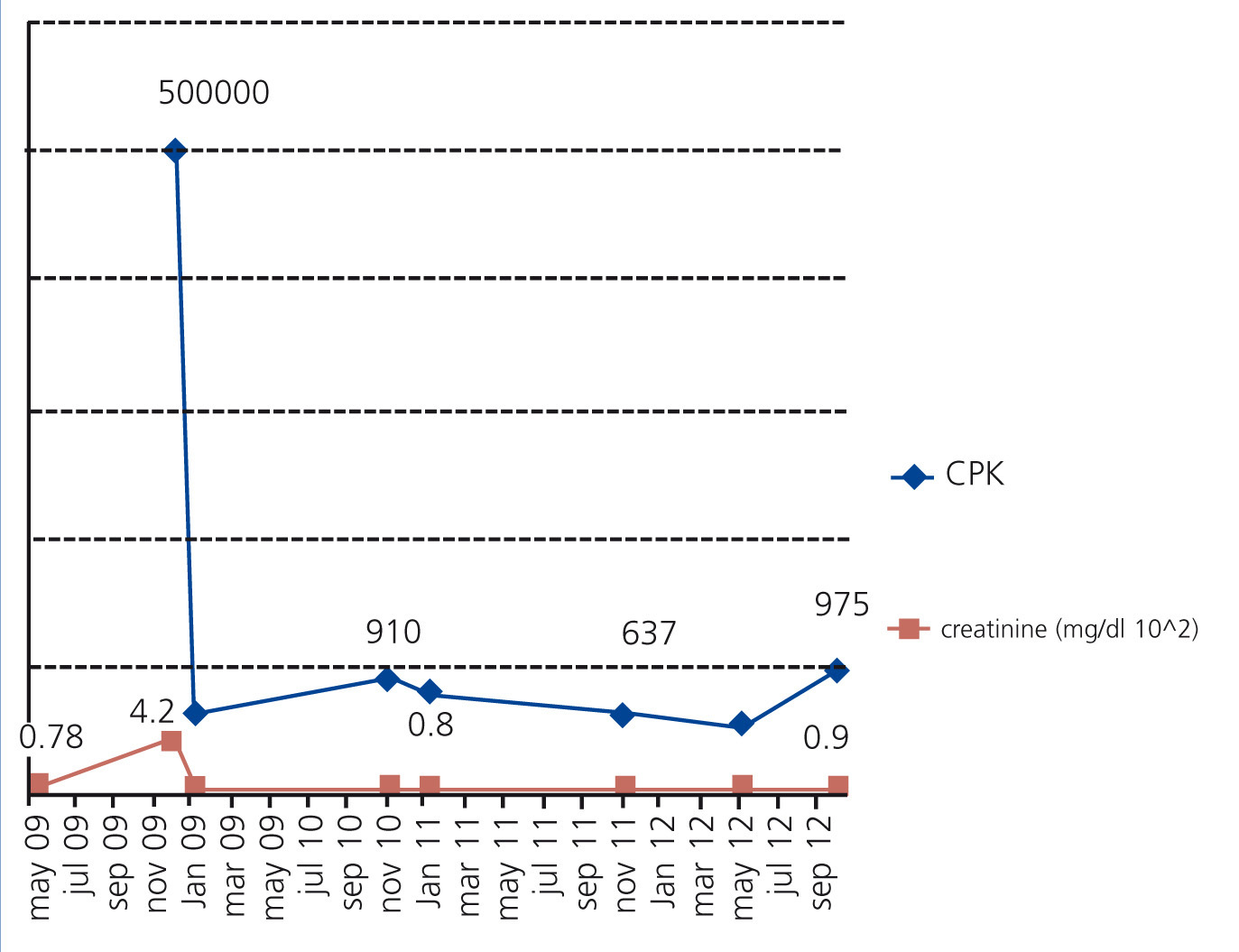To the Editor:
McArdle’s disease or glycogen storage disease type V is a hereditary autosomal recessive metabolic myopathy caused by the total or partial deficiency of an enzyme located in the skeletal muscles, myophosphorylase. Muscle involvement is a consistent feature, with renal involvement being less common.
We report the case of a 42-year-old male with previous acute renal failure (ARF) (creatinine 4.8mg/dl) secondary to severe rhabdomyolysis (creatine phosphokinase [CPK] 500,000IU/l) of unclear aetiology. At discharge, the patient had recovered renal function (creatinine 0.8mg/dl, glomerular filtration rate 93ml/min/1.73m2) with a decrease in CPK levels to 420IU/l (Figure 1). He reported a history of type 2 diabetes mellitus and high blood pressure, both of which were well controlled. He complained of myalgias in distal extremities from an early age and intolerance to physical exercise. During clinical follow-up, CPK levels remained high and we ruled out pharmacological and toxic aetiologies, among others. We decided, in conjunction with Neurology, to request an electromyogram, which was unremarkable, but the muscle biopsy revealed the presence of subsarcolemmal and intermyofibrillar vacuoles with positive PAS (periodic acid Schiff) material corresponding to glycogen storage, and did not reveal activity of the enzyme myophosphorylase, which confirmed the diagnosis of a myopathy, glycogen storage disease type V. The genetic study was positive for mutation PYGM T2392C in homozygosis. McArdle’s disease was the definitive diagnosis.
McArdle’s disease is an uncommon but underdiagnosed condition and its prevalence is 1/167,000.1 Symptoms appear from an early age (childhood or adolescence), although they vary according to the patient and include myalgia, muscle cramp, intolerance to exercise and muscle exhaustion when the slightest effort is exerted.1,2 Occasionally, more than one family member has the same symptoms, which is cause for clinical suspicion, but a muscle biopsy and genetic study are necessary for confirmation. Renal involvement is uncommon,2,3 although there have been reports of chronic renal failure due to tubulointerstitial nephropathy secondary to repeated episodes of rhabdomyolysis.4 Some authors describe the involvement of predisposing factors, such as previous alcohol consumption and statin use.2 Patients progress with fluctuating levels of CPK in blood, associated with muscle damage and regeneration. Severe rhabdomyolysis is uncommon, but it causes kidney damage due to the massive release of myoglobin, resulting in intratubular obstruction, acute tubular necrosis or functional impairment due to the decreased effective circulating volume caused by the retention of sodium and water in damaged myocytes.2 The presence of residual activity of muscle phosphorylase is related to mild clinical symptoms, while in the absence of this enzyme’s activity, infections and a history of vigorous physical exercise can trigger more severe rhabdomyolysis,2,3 as was the case in our patient.
General treatment focusses on improving the quality of life of these patients, adapting their daily activity through training, physiotherapy and glucose intake just before exercise, achieving a biological adaptation to McArdle’s disease.5 Some authors recommend the administration of vitamin B6 and B12 supplements, although their use has not been linked to a clear improvement of symptoms or a decreased risk of rhabdomyolysis. The indication of renal replacement therapy meets the same criteria as other ARF entities that present with massive rhabdomyolysis.
To conclude, we should suspect metabolic myopathy in young patients who have persistently high levels of CPK associated with muscle symptoms at an early age. Its early diagnosis and recommendations based on a change of lifestyle in patients will avoid serious and systemic consequences, including rhabdomyolysis-induced ARF.
Conflicts of interest
The authors declare that they have no conflicts of interest related to the contents of this article.
Figure 1. Progression of creatine phosphokinase and creatinine in plasma








